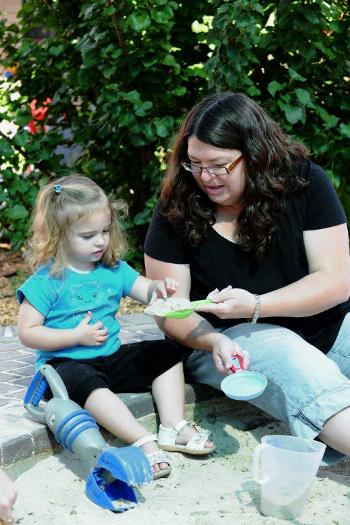Digging
Duration/age

Are we digging to China or a tunnel under the sea?
Digging can be done just about anywhere. You can do it in your backyard, at the park or the beach, or in the kitchen when you dig out a scoop of ice-cream.
You and your child can get creative and make tunnels that travel from one country to another. Your child could help you dig a hole to plant a new lemon tree, make a trench for a stormwater pipe or get a new garden bed ready for the veggies.
If your child is going to help you get the job done, talk to them about what you need to do and how big or how long the hole or trench needs to be. Show them what tools you will use, where to stand and where the soil will go once it has been dug up.
As you work together compare the plant with the size of the hole. Is the hole big enough or too small? How can you know how big the hole needs to be?
Look at the label on the lemon tree. It says the roots need to be 10cm under the ground and the hole twice as wide as the root ball.
Materials you will need
- Bucket
- Spade
- Sand
- Soil
- Your hands and fingers
Alternative tools
- Pots
- Spoon
- Potting mix
- Sandpit
- Truck
Skills this activity improves
Why does this matter?
Digging helps children to develop language and motor skills, and experiment with the different ways we measure. As your child digs they are experimenting with the different language we use to describe measurement and space.
When your child works with you to complete a task, they are exploring position and how to move their bodies and the spade within a confined space. They are experimenting with how close they can get to the hole before the edges cave in or which side to work from.
As they dig they are developing large and small muscles in their bodies. They are developing strength, control and coordination in all of their body parts including the large muscles in their trunk. Having a strong core, or trunk, is important as it helps children with good sitting posture.
What does this lead to?
As your child digs they are exploring the space around them and the relationship between people and objects nearby. As they explore space they are developing mathematical ways of thinking. Mathematical thinking involves using memory, learning how to orient your body in space and making judgements about distance and size.
As the hole gets bigger your child will be hearing and using the different words and language we use to measure and describe size. This helps them to understand that we change words or language to describe an attribute of an object. The attribute could be time, temperature, size, space or capacity.
If children do not have a good sitting posture they are not able to write for long periods of time because they will get tired and start to lean on the desk. Leaning over affects the range of movement children have for writing and drawing.
Language to use
- Hole
- Ground, soil, dirt, sand, potting mix
- Damp, dry, sloppy, liquid, solid
- Side, edges, top, bottom, against, next to, under, over
- Shallow, deep
- Big, small, large, medium
- Dig, scoop, reach, empty, fill, place, pile, tip
Questions to use
- How big will the hole be?
- Do we need a deep or shallow hole?
- Why don’t the sides of the hole fall in?
- Where does the soil from the hole go?
Useful tips
- Dry sand can be tricky to dig in. Try wetting the sand before you start.
- Show your child how to tip the sand off the shovel. This will help them to learn not to throw sand.
- You might also like to take a look at the activities Treasure hunt and Reading a map.
- Remember to talk to your child in your home language.
More ideas
- On wet days you could set up a sand tray inside. Try digging with spoons that are different sizes.
- Bury treasure in a sand tray, but don’t tell your child. They will get an enormous surprise when they dig up the treasure.
- Make a treasure map. Bury treasure to find at different points along the way.
Variation by age
Birth to two year olds
- Dig a tunnel to drive a toy car through.
- Fill up a bucket and make a sandcastle.
- Dig a moat around your sandcastle.
- Let your child help you to plant seeds in the garden.
- Play together in the sandpit.
Three to five year olds
- Plant a vegetable garden together.
- Create a river system in the sandpit. See if the boat can make it all the way down the river.
- Visit the dinosaur bones at the museum. Make your own archaeological dig at home.
- Make a measuring stick and use it to compare how big or deep the holes and trenches are.
Questions to ask
- Is it full?
- How big is the hole?
- Does the car go under the sand or over?
Questions to ask
- How close together do the seedlings go?
- How deep does the hole need to be?
- Which hole is bigger?
- Is the river wide enough?
- How do you know what is under the ground?
Language to use
- Full, empty, half
- Under, over, around, outside
- Down
- Dig, fill, pile
Language to use
- Deep, shallow, wide, narrow, close
- Under, over, around
- Measure, compare
- Bigger, smaller


